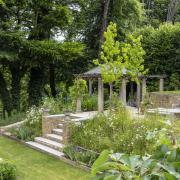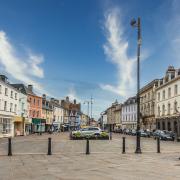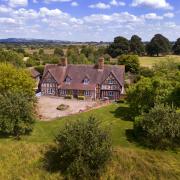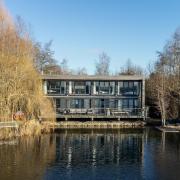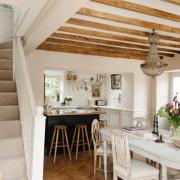It’s the setting as much as the collection of trees that makes Batsford Arboretum special. The elevated site gives long views over the Cotswold countryside while sloping ground allows you to look down on the display, giving a unique perspective. Whether it be against clear skies on a crisp autumn morning or with low-hanging mist in the air, the experience is magical.
For head gardener and assistant director Matthew Hall, it’s a display that always offers something new, even after 21 years at Batsford.
‘Each year there’ll be something that I’ll think ‘You know what, that’s pretty impressive’ and you’ll see something different each time,’ he says.

Then there are the acers whose leaves are turning gold, red and orange and no autumn visit is complete without catching the candyfloss scent of the katsura (Cercidiphyllum japonicum). Its foliage goes pink, yellow and orange while the burnt sugar scent carries for some distance.
‘It’s incredible,’ says Matt, who heads up the three-strong gardening team at the site near Moreton-in-Marsh.

He worked for the government in China, Japan and Russia, developing a love for oriental-style gardens that he brought back to Batsford.
‘He didn't want the raked gravel effect, the clean, crisp shape,’ explains Matt. ‘He liked the wild effect. It was not as ‘kept’ as some would say.’ This was despite the estate employing more than 100 gardeners within the arboretum and walled garden.

One of his biggest contributions was the creation of the 600m-long water course that snakes its way through the arboretum, past the Pulhamite rockery bridge, ending in a grotto, waterfall and the Coldwell Lake.
The second major influence on Batsford was the 2nd Baron Dulverton, who inherited the by then overgrown wild garden in 1956.

While it may be primarily a collection of trees with more than 2,800 planted, there’s a distinctly garden-like feel to the 68-acre Batsford, thanks to the team’s determination to both extend the season of interest and the selection of plants within each season.
‘It’s not just an arboretum,’ says Matt. ‘There’s a background of trees but we’re more than that.

He starts with what he calls the ‘lower canopy’ and works up from that. So, winter sees a sizeable display of snowdrops hellebores, witch hazel and daphne, giving way to daffodils and moving on to magnolias, cherry blossom and wildflowers.
There are shrubs to give mid-storey interest – recently, Matt has been planting more Hydrangea paniculata cultivars: ‘They’d become unfashionable and I thought they should be brought back in.

Then, the trees themselves are used as ‘props’ for other things, such as a yew that supports an ornamental vine, Vitis flexuosa, collected in China.
‘It never fails. It’s just crimson red, acid yellow, and flame.’
One development has seen replanting at the entrance to the arboretum, known as Her Ladyship’s Walk. On the shady side of the path, there are winter stars, including snowdrops, winter aconites and daphnes for early scent. Opposite are the sun-lovers, such as hoherias from Tasmania, indigoferas, magnolia and Mexican philadelphus.

As part of the arboretum’s scientific work, it’s part of a project run by Edinburgh Botanic Garden designed to safeguard threatened species of the monkey puzzle tree. Batsford is just one site where trees that are endangered in the wild have been planted.
‘Part of our work is growing endangered plants and mixing them within the arboretum.’
Endangered species are just some of the around 70 new trees planted each year with the team taking a long view.

‘We’re looking at trends in the weather, changing weather patterns and looking at planting for the future.
‘We may have some historic trees but an arboretum is not a museum. They don’t stay the same.’

‘It’s all about knowledge of the grounds and planting locations. Fortunately, we’re aware of frost pockets where it could be colder in winter so tend to avoid those areas.’
In autumn though, it’s the firework array of colour that sees thousands of people visit – it’s now so popular tickets have to be booked in advance.

And his tip for visitors? ‘Make more than one visit over autumn to capture the array of colours. Everything changes so quickly, you’ll be gifted a completely different scene that’s equally as beautiful over a matter of days. It’s a feast for the eyes.’
More information is on the website: https://batsarb.co.uk
Instagram: @thechattygardener
Facebook: The Chatty Gardener
X: @ChattyGardener
© Mandy Bradshaw




